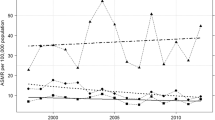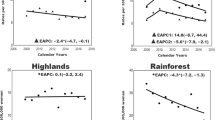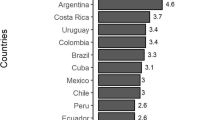Abstract
Purpose
This study aimed to correct and describe cervical cancer mortality rates and trends by regions and age-groups in Brazil. It may help planning and implementing policies for cervical cancer control.
Methods
Data from 2003 to 2012 were accessed through the centralized national mortality database. Correction of the age-specific mortality rates was done by proportional redistribution of ill-defined causes of death and deaths coded as ‘uterine, part unspecified’. Annual percentage change (APC) was obtained by trend analysis (Joinpoint regression).
Results
In the 10-year period, cancer and ill-defined causes corresponded, respectively, to 18.9 and 10.8 % of all deaths (except injuries). The proportion of ill-defined causes was reduced by more than a half in the period. The age-standardized cervical cancer mortality rate was 7.2 per 100,000 women-years after correction. The total increase in rates after corrections was 50.5 %. A significant decreasing trend in rates was observed at the national level (APC = −0.17, p < 0.001). North was the only region that did not show a decreasing significant trend (APC + 0.07, p = 0.28). Decreasing trends were restricted to age-groups over 40 years.
Conclusions
A consistent decreasing trend of cervical cancer mortality rates in Brazil from 2003 to 2012 was observed, although this was not consistent in all regions and restricted to older age-groups. Quality of data needs to be improved. Cancer control policies may consider the differences in access to care and the characteristics of regions to improve their efficiency.



Similar content being viewed by others
References
International Agency for Research on Cancer. GLOBOCAN (2012): estimated cancer incidence, mortality and prevalence worldwide in 2012. Fact sheets by population. http://globocan.iarc.fr/Pages/fact_sheets_population.aspx. Accessed 10 June 2015
Bray F, Jemal A, Grey N et al (2012) Global cancer transitions according to the Human Development Index (2008–2030): a population-based study. Lancet Oncol 13:790–801
The United Nations Development Programme PNUD Brasil - Programa das Nações Unidas para o Desenvolvimento. http://www.pnud.org.br/. Accessed 21 Oct 2015
Brasil. Ministério da Saúde - Secretaria de Vigilância em Saúde. TabNet: Mortalidade - Brasil. http://tabnet.datasus.gov.br/cgi/deftohtm.exe?sim/cnv/obt10uf.def. Accessed 28 May 2015
Instituto Nacional de Câncer (Brazil) Atlas On-line de Mortalidade. https://mortalidade.inca.gov.br/MortalidadeWeb/. Accessed 16 Apr 2015
Curado MP, Voti L, Sortino-Rachou AM (2009) Cancer registration data and quality indicators in low and middle income countries: their interpretation and potential use for the improvement of cancer care. Cancer Causes Control 20:751–756. doi:10.1007/s10552-008-9288-5
Gonzaga CMR, Freitas-Junior R, Barbaresco AA et al (2013) Cervical cancer mortality trends in Brazil: 1980–2009. Cad Saúde Pública 29:599–608
Girianelli VR, Gamarra CJ, Azevedo e Silva G (2014) Disparities in cervical and breast cancer mortality in Brazil. Rev Saúde Pública 48:459–467. doi:10.1590/S0034-8910.2014048005214
de Souza DLB, Curado MP, Bernal MM et al (2013) Mortality trends and prediction of HPV-related cancers in Brazil. Eur J Cancer Prev Off J Eur Cancer Prev Organ ECP 22:380–387. doi:10.1097/CEJ.0b013e32835b6a43
World Development Indicators|World DataBank. http://databank.worldbank.org/data/reports.aspx?source=2&country=BRA&series=&period. Accessed 6 Oct 2015
Brasil. Instituto Brasileiro de Geografia e Estatística. Indicadores Econômicos. http://www.ibge.gov.br/home/mapa_site/mapa_site.php#economia. Accessed 13 Oct 2015
Macinko J, Harris MJ (2015) Brazil’s family health strategy—delivering community-based primary care in a universal health system. N Engl J Med 372:2177–2181
Brasil. Agência Nacional de Saúde Suplementar. ANS Tabnet - Informações em Saúde Suplementar: Beneficiários. http://www.ans.gov.br/anstabnet/cgi-bin/dh?dados/tabnet_br.def. Accessed 12 June 2015
Bruni L, Barrionuevo-Rosas L, Albero G, Aldea M, Serrano B, Valencia S, Brotons M, Mena M, Cosano, R, Muñoz J, Bosch FX, de Sanjosé S, Castellsagué X. ICO Information Centre on HPV and Cancer (HPV Information Centre). Human Papillomavirus and Related Diseases in Brazil. Summary Report. Accessed 20 Mar 2015
Brasil. Ministério da Saúde—DATASUS SI-PNI Sistema de Informação do Programa Nacional de Imunização. http://pni.datasus.gov.br/. Accessed 16 Apr 2015
Instituto Nacional de Câncer (Brazil) (2011) Diretrizes brasileiras para o rastreamento do câncer do colo do útero. INCA, Rio de Janeiro
Thuler LCS, de Aguiar SS, Bergmann A (2014) Determinants of late stage diagnosis of cervical cancer in Brazil. Rev Bras Ginecol Obstet 36:237–243
Instituto Nacional de Câncer (Brazil) Registros de Câncer de Base Populacional. http://www2.inca.gov.br/wps/wcm/connect/estatisticas/site/home/rcbp/. Accessed 8 Sept 2015
Mathers CD, Ma Fat D, Inoue M et al (2005) Counting the dead and what they died from: an assessment of the global status of cause of death data. Bull World Health Organ 83:171–177c
Franca E, de Abreu DX, Rao C, Lopez AD (2008) Evaluation of cause-of-death statistics for Brazil, 2002–2004. Int J Epidemiol 37:891–901. doi:10.1093/ije/dyn121
França E, Teixeira R, Ishitani L et al (2014) Ill-defined causes of death in Brazil: a redistribution method based on the investigation of such causes. Rev Saúde Pública 48:671–681. doi:10.1590/S0034-8910.2014048005146
Loos AH, Bray F, McCarron P et al (2004) Sheep and goats: separating cervix and corpus uteri from imprecisely coded uterine cancer deaths, for studies of geographical and temporal variations in mortality. Eur J Cancer 40:2794–2803. doi:10.1016/j.ejca.2004.09.007
Gamarra CJ, Valente JG, Silva GA (2010) Correction for reported cervical cancer mortality data in Brazil. Rev Saúde Pública 44(4):629–638. doi:10.1590/S0034-89102010000400006
Silva GA, Gamarra CJ, Girianelli VR, Valente JG (2011) Cancer mortality trends in Brazilian state capitals and other municipalities between 1980 and 2006. Rev Saúde Pública 45:1009–1018
World Health Organization WHO Global Burden of Disease Publications. In: WHO. http://www.who.int/healthinfo/global_burden_disease/publications/en/. Accessed 3 Nov 2015
Brasil. Instituto Brasileiro de Geografia e Estatística. Projeção da População das Unidades da Federação por sexo e idade: 2000–2030. http://www.ibge.gov.br/home/estatistica/populacao/projecao_da_populacao/2013/default.shtm. Accessed 28 May 2015
Ahmad OB, Boschi-Pinto C, Lopez AD, et al (2001) Age standardization of rates: a new WHO standard. World Health Organization Geneva
Lăără E, Day NE, Hakama M (1987) Trends in mortality from cervical cancer in the Nordic countries: association with organised screening programmes. Lancet 1:1247–1249
Murillo R, Almonte M, Pereira A et al (2008) Cervical cancer screening programs in Latin America and the Caribbean. Vaccine 26:L37–L48. doi:10.1016/j.vaccine.2008.06.013
Madlensky L, Goel V, Polzer J (1990) Ashbury FD (2003) Assessing the evidence for organised cancer screening programmes. Eur J Cancer Oxf Engl 39:1648–1653
Vale DB, Braganca JF, Morais SS, Zeferino LC (2014) Protection against squamous cell carcinoma and cervical adenocarcinoma afforded by cervical cytology screening: a cross-sectional study. Int J Gynecol Cancer Off J Int Gynecol Cancer Soc 24:321–328. doi:10.1097/IGC.0000000000000057
Castanon A, Leung VMW, Landy R et al (2013) Characteristics and screening history of women diagnosed with cervical cancer aged 20–29 years. Br J Cancer 109:35–41. doi:10.1038/bjc.2013.322
Silva Gulnar Azevedo, Gamarra CJ, Girianelli VR et al (2010) Cervical cancer mortality trends in Brazil, 1981–2006. Cad Saúde Pública 26:2399–2407
Shack L, Jordan C, Thomson CS et al (2008) Variation in incidence of breast, lung and cervical cancer and malignant melanoma of skin by socioeconomic group in England. BMC Cancer 8:271. doi:10.1186/1471-2407-8-271
Clegg LX, Reichman ME, Miller BA et al (2009) Impact of socioeconomic status on cancer incidence and stage at diagnosis: selected findings from the surveillance, epidemiology, and end results: national longitudinal mortality study. Cancer Causes Control CCC. doi:10.1007/s10552-008-9256-0
Arbyn M, Raifu AO, Weiderpass E et al (2009) Trends of cervical cancer mortality in the member states of the European Union. Eur J Cancer 45:2640–2648. doi:10.1016/j.ejca.2009.07.018
Capocaccia R, Martina L, Inghelmann R et al (2009) A method to estimate mortality trends when death certificates are imprecisely coded: an application to cervical cancer in Italy. Int J Cancer 124:1200–1205
FIGO Committee on Gynecologic Oncology (2014) FIGO staging for carcinoma of the vulva, cervix, and corpus uteri. Int J Gynaecol Obstet Off Organ Int Fed Gynaecol Obstet 125:97–98. doi:10.1016/j.ijgo.2014.02.003
Acknowledgments
The work reported here was undertaken during the tenure of a Postdoctoral Fellowship from the International Agency for Research on Cancer, partially supported by the European Commission FP7 Marie Curie Actions—People—Co-funding of regional, national, and international programs (COFUND).
Author information
Authors and Affiliations
Corresponding author
Ethics declarations
Conflict of interest
The authors declare that they have no conflict of interest.
Rights and permissions
About this article
Cite this article
Vale, D.B., Sauvaget, C., Muwonge, R. et al. Disparities in time trends of cervical cancer mortality rates in Brazil. Cancer Causes Control 27, 889–896 (2016). https://doi.org/10.1007/s10552-016-0766-x
Received:
Accepted:
Published:
Issue Date:
DOI: https://doi.org/10.1007/s10552-016-0766-x




